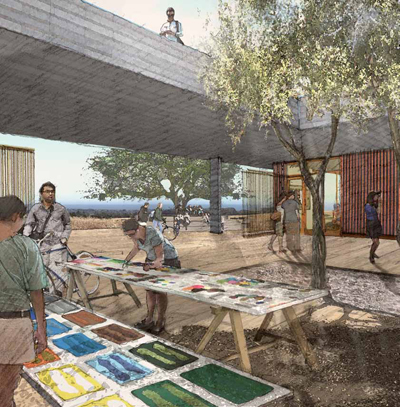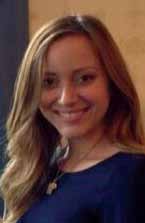Campus News
This is UC Santa Cruz
News and people of note at UC Santa Cruz.
Acclaimed architects to design new institute

Conceived as more than a museum, the institute will be the first of its kind at a research university, focusing on both the arts and the sciences and their relationship to other disciplines. Designed to function as an intellectual hub, it will provide space for site-specific installations, exhibits, seminars, residencies by artists and scholars, and hands-on research by students and faculty.
With a national and international scope, the institute will also curate traveling art exhibitions and create projects linked to the university curriculum, drawing from the rich archives and collections of all of the UC campuses.
Major (and minor) news
Beginning this fall, UC Santa Cruz will offer two new programs:
• A major in Critical Race and Ethnic Studies (CRES), leading to a new bachelor of arts degree;
• A minor in sustainability studies with an engineering component aimed at giving students hands-on experience that can lead to jobs in a “green economy.”
Curriculum for CRES, administered by the Humanities Division, will draw from the campus’s Anthropology, Education, Feminist Studies, History, Film and Digital Media, Literature, History of Art and Visual Culture, Latin American and Latino Studies, Psychology, and Sociology departments.
The sustainability minor, which will accept 30 students during its first year, is multidisciplinary and is affiliated with College Eight.
More science honors


The election “shows the growing impact that UC Santa Cruz faculty are having across all the sciences,” said Paul Koch, dean of physical and biological sciences. (For more on Lay’s work, see “Orders of magnitude“).
Estes’s work has revealed how predators can profoundly shape ecosystems, leading him to argue that their loss is of great concern for conservation biology. Lay’s innovations in the study of earthquakes have generated insights about the structure of the deep Earth and how the Earth ruptures to generate quakes.
Learning by doing
UC Santa Cruz will undertake an ambitious program to revamp its introductory courses in biology, chemistry, and physics, replacing lectures with a more active learning approach.
Funded by a $1.5 million grant from the Howard Hughes Medical Institute, the effort is intended to ensure that more of the students who enter UC Santa Cruz planning to study science persist through the required courses to earn a science degree.
Paul Koch, dean of physical and biological sciences, will oversee the program and develop faculty teams to work on the different introductory course series.
“It’s a big step forward for the campus,” Koch said. “Our goal is to use a more active learning approach—instead of lecturing, we will have students learn by doing.”
POTUS notice

First, the 19-year-old Oakes College student was invited to the White House Science Fair to demonstrate her “Concussion Cushion,” a rubberized covering for football helmets to lessen the impact to players’ heads. She had created the science project last year as a high school senior, and it won the top school and county prizes and placed in the 2013 California State Science Fair.
Then, President Obama invited her to return to the White House two days later for his summit on youth sports and concussions.
Graduate enrollment up sharply
Enrollment of grad students at UC Santa Cruz for fall 2014 has topped 1,625, the largest cohort in the campus’s history—9 percent of total enrollment.
The increase is consistent with an upward trend that’s been happening since 2007. Grad enrollment was 1,465 in 2013 and 1,389 in 2012.
Fueling the growth is a record incoming class for fall, estimated at 550 new grad students, up from 460 last year and 391 the previous year.
“This growth illustrates the continuing strong upward trend in UC Santa Cruz’s attractiveness and reputation as a doctoral-granting and research institution,” said Tyrus Miller, vice provost and dean of graduate studies. “We hope to match the size and proportion of graduate education at other UC campuses where the percentage of grad students is typically more than 15 percent.”
Julie Packard: philanthropy and pragmatism

Packard, daughter of high-tech pioneer David Packard, says pragmatism runs deep in her family’s blood.
“My father was a very practical person and not really a dreamer,” remembered Packard of the man who co-founded Hewlett-Packard.
Philanthropy, she said, was also an early value, inculcated even before David Packard grew wealthy.
“Having resources to share is a gift, an opportunity,” Packard said.
But a big checkbook isn’t the only answer, she said. Change can come from acts as simple as voting, putting social media pressures on government, volunteering, and standing up for what you believe. “I think all of us need to engage,” she said.
Mixing it up on Science Hill
An innovative graduate program is breaking down barriers between the biomedical sciences, encouraging interdisciplinary learning on Science Hill, and enabling students from different divisions to work closely together.
Now in its sixth year, the graduate Program in Biomedical Sciences and Engineering (PBSE) is a collaborative graduate program that includes faculty from five departments spanning the Divisions of Physical and Biological Sciences and the Baskin School of Engineering.
Originally, departments had their own graduate programs, “but research has evolved to where students now employ techniques and logic from multiple disciplines,” said PBSE director Seth Rubin, chemistry and biochemistry professor.
“We needed a graduate program that reflects the collaborative and interdisciplinary nature of biomedical research at UC Santa Cruz,” said Doug Kellogg, Molecular, Cell and Developmental biology professor and PBSE’s founding director.
Communication about science even spills over into the social realm.
“I’ll walk downtown and see students from different tracks hanging out together,” Kellogg said.
Plaque honors Jack

Baskin has been actively supporting engineering programs at UC Santa Cruz for several decades, providing guidance to faculty and campus leadership as well as generous financial support. His cornerstone gift helped launch the Baskin School of Engineering in 1997, and his donations to the engineering school now total $8.8 million. Baskin and his wife, Peggy Downes Baskin, have also supported many other campus programs.
“When you look around UC Santa Cruz, you see Jack Baskin’s influence everywhere,” said Chancellor Blumenthal. “From engineering to the arts and humanities, his support transforms lives through scholarships, programs that open doors for our students, and endowed chairs for faculty that propel research and discovery.”
New librarian in town

A leading voice in state and national advocacy efforts on behalf of university libraries, Cowell has 20 years of management experience in academic libraries with a strong record of accomplishment and strategic leadership in operations, fundraising, and innovation.
Cowell served as University Librarian at UC Santa Cruz in an interim capacity since July 15, 2013. She first came to the campus in 2008 as the Associate University Librarian for Public Services, where she worked with administration and staff to absorb challenging budget cuts while maintaining core library services.
Cowell played an integral role in the recent expansion and renovation of McHenry Library, implementing changes that have resulted in a dramatic increase in library attendance.